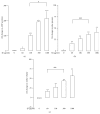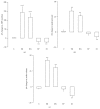Sibjotang Increases Atrial Natriuretic Peptide Secretion in Beating Rabbit Atria
- PMID: 26495007
- PMCID: PMC4606132
- DOI: 10.1155/2015/268643
Sibjotang Increases Atrial Natriuretic Peptide Secretion in Beating Rabbit Atria
Abstract
Sibjotang (Shizaotang), traditional herbal medicine formula, which was first documented in the Shanghanlun, has long been prescribed for the treatment of impairment of the body fluid homeostasis. The purpose of the present study was to identify the effects of Sibjotang on the secretion of a cardiac hormone, atrial natriuretic peptide (ANP), one of the main hormones involved in the regulation of the body fluid and blood pressure homeostasis. Water extract of Sibjotang increased ANP secretion concomitantly with an increase in atrial dynamics in a concentration-dependent manner. Sibjotang-induced increase in ANP secretion and positive inotropic effect were attenuated by GO6976 and LY333531, selective inhibitors of conventional protein kinase C, but not Rottlerin, an inhibitor of novel PKC δ . Similarly to the effect of Sibjotang, extracts of components of Sibjotang, Euphorbia kansui, and Daphne genkwa, but not Euphorbia pekinensis and Ziziphus jujuba, increased ANP secretion and atrial dynamics. Ingredients of Sibjotang, apigenin, rosmarinic acid, and salvianolic acid B decreased ANP secretion and atrial dynamics. These findings suggest that Sibjotang increases ANP secretion and atrial dynamics via activation of conventional protein kinase C signaling. This finding provides experimental evidence for the rationale in the use of Sibjotang in the treatment of impairment of the regulation of body fluid and blood pressure homeostasis.
Figures







Similar articles
-
Emodin accentuates atrial natriuretic peptide secretion in cardiac atria.Eur J Pharmacol. 2014 Jul 15;735:44-51. doi: 10.1016/j.ejphar.2014.04.014. Epub 2014 Apr 18. Eur J Pharmacol. 2014. PMID: 24751713
-
Gallic acid increases atrial natriuretic peptide secretion and mechanical dynamics through activation of PKC.Life Sci. 2017 Jul 15;181:45-52. doi: 10.1016/j.lfs.2017.05.024. Epub 2017 May 20. Life Sci. 2017. PMID: 28535942
-
Ursolic acid increases the secretion of atrial natriuretic peptide in isolated perfused beating rabbit atria.Eur J Pharmacol. 2011 Feb 25;653(1-3):63-9. doi: 10.1016/j.ejphar.2010.10.098. Epub 2010 Nov 29. Eur J Pharmacol. 2011. PMID: 21122803
-
Mechanisms of mechanical load-induced atrial natriuretic peptide secretion: role of endothelin, nitric oxide, and angiotensin II.J Mol Med (Berl). 1997 Nov-Dec;75(11-12):876-85. doi: 10.1007/s001090050179. J Mol Med (Berl). 1997. PMID: 9428620 Review.
-
Atrial natriuretic peptide in brain and pituitary gland.Physiol Rev. 1997 Apr;77(2):465-515. doi: 10.1152/physrev.1997.77.2.465. Physiol Rev. 1997. PMID: 9114821 Review.
Cited by
-
Sibjotang Protects against Cardiac Hypertrophy In Vitro and In Vivo.Life (Basel). 2023 Dec 7;13(12):2307. doi: 10.3390/life13122307. Life (Basel). 2023. PMID: 38137908 Free PMC article.
-
Yuanhuacin and Related Anti-Inflammatory and Anticancer Daphnane Diterpenes from Genkwa Flos-An Overview.Biomolecules. 2022 Jan 23;12(2):192. doi: 10.3390/biom12020192. Biomolecules. 2022. PMID: 35204693 Free PMC article. Review.
References
LinkOut - more resources
Full Text Sources
Other Literature Sources

